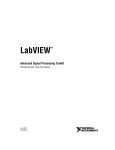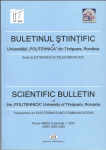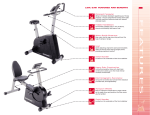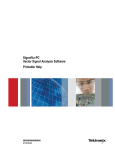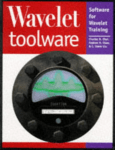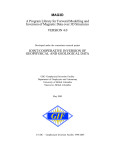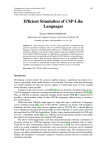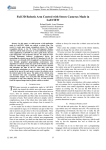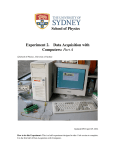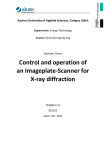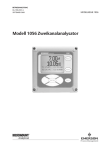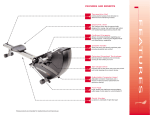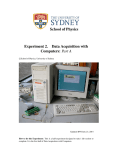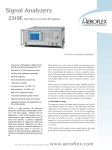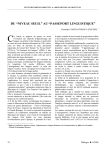Download Graphical Programming based Biomedical Signal Acquisition and
Transcript
INTERNATIONAL JOURNAL OF CIRCUITS, SYSTEMS AND SIGNAL PROCESSING Graphical Programming based Biomedical Signal Acquisition and Processing Mihaela Lascu, Dan Lascu A computer based system consists of a few external hardware components for isolation and amplification of the signals, a data acquisition card and a software analysis package as shown in Fig. 1. Acquisition of the signal can be handled through built-in procedures and LabVIEW’s ability to easily create a user interface. The analysis of the received signal can be performed by ready made procedures which can be obtained from National Instruments. Abstract—This paper describes a computer based signal acquisition, processing and analysis system using LabVIEW, a graphical programming language for engineering applications. Biomedical signal acquisition has greatly advanced over the years, using many different technologies. E series multifunction data acquisition cards are used for the acquisition of biomedical signals and the appropriate software NI-DAQ (National Instruments – Data Acquisition). With the increasing performance of the personal computer, computer based signal processing systems are becoming an efficient and cost-effective way of acquiring and analyzing these signals. The advanced analysis techniques available on the computer are becoming invaluable to the practicing physician. The diagnostic decision will be more accurate. Peak detection in electrocardiogram (ECG) is one of the solved problems using LabVIEW and filtering biomedical signals in different ways is a challenge that has to be solved. II. DATA ACQUISITION Keywords—biomedical signal, data acquisition, graphical programming language, signal processing. I. INTRODUCTION C OMPUTERS are becoming a necessity in the medical community. Physicians use computers for patient records and information. It is obvious that personal computers based signal acquisition and analysis is an efficient and cost effective method of patient biomedical signal acquisition and monitoring. Fig. 1. Computer based biomedical signal acquisition and analysis system. Manuscript received April 11, 2007: Revised version received November 18, 2007. Mihaela Lascu is with Politehnica University Timisoara, Faculty of Electronics and Telecommunicatons, Department of Measurements and Optical Electronics, Romania (corresponding author to provide phone: 0040256-275488; e-mail: mihaela.lascu@ etc.upt.ro). Dan Lascu is with Politehnica University Timisoara, Faculty of Electronics and Telecommunicatons, Department of Applied Electronics, Romania (corresponding author to provide phone: 0040-256-275488; e-mail: dan.lascu@ etc.upt.ro). Issue 4, Volume 1, 2007 317 A wide range of data acquisition cards is available from National Instruments. These cards provide for multiple channels of analog data input as well as output. In addition LabVIEW comes with ready-made libraries for interfacing with these DAQ cards. Using these libraries, programs for the data acquisition are quickly and easily made for allowing more time to be spent on the processing and analysis of the acquired signals. We used National Instruments PCI-6023E board from the 6023E, 6024E and 6025E family. The 6025E features 16 channels (eight differential) of analog input, two channels of analog output, a 100-pin connector, and 32 lines of digital I/O. The 6024E features 16 channels of analog input, two channels of analog output, a 68-pin connector and eight lines of digital I/O. The 6023E is identical to the 6024E, except that it does not have analog output channels. The NI-DAQ driver software is included with all National Instruments DAQ hardware. NI-DAQ is not packaged with SCXI (Signal Conditioning Extended Instruments) or accessory products, except for the SCXI-1200. NI-DAQ has an extensive library of functions that you can call from your application programming environment. These functions include routines for analog input (A/D conversion), buffered data acquisition (high-speed A/D conversion), analog output (D/A conversion), waveform generation (timed D/A conversion), digital I/O, counter/timer operations, SCXI, selfcalibration, messaging, and acquiring data to extended memory. NI-DAQ also internally addresses many of the complex issues between the computer and the DAQ hardware such as programming interrupts and DMA controllers. NI-DAQ maintains a consistent software interface among its different versions so that you can change platforms with minimal modifications to your code. Whether we are using conventional programming languages or National Instruments application software, our application uses the NI-DAQ driver INTERNATIONAL JOURNAL OF CIRCUITS, SYSTEMS AND SIGNAL PROCESSING The boards have three different input modes— nonreferenced single-ended (NRSE) input, referenced singleended (RSE) input, and differential (DIFF) input. The singleended input configurations provide up to 16 channels. The DIFF input configuration provides up to eight channels. Input modes are programmed on a per channel basis for multimode scanning. It is possible to configure the circuitry to scan 12 channels - four differentially configured channels and eight single-ended channels. Table 1 describes the three input configurations. If conference, please contact your conference editor concerning acceptable word processor formats for your particular conference. software, as illustrated in Fig.2. Table I Fig. 2. Relationship between the programming environment, NI-DAQ and DAQ-Card. After installing NI-DAQ device drivers we obtain on the desktop of the computer an icon named MAX – Measurement and Automation Explorer. This program is necessary for identifying the presence of the DAQ-card and for settling the channels that will be used. Measurement and Automation Explorer (MAX) provides access to our PCI-6023E DAQ acquisition card. MAX can manage devices and interfaces, the installed National Instruments software, virtual channels or tasks for the used devices and as well it can create scales for the realised virtual instrument, can configure the IVI – Interchangeable Virtual Instrument drivers and import/export the device configuration file. An overview of the hardware functions of PCI-6023E board is presented in Fig.3. In our application we use the RSE – reference single ended – configuration, for example between AICH1 (PIN 33) and AIGND (PIN 32) for one channel. The boards have a bipolar input range that changes with the programmed gain. Each channel may be programmed with a unique gain of 0.5, 1.0, 10, or 100 to maximize the 12-bit analog-to-digital converter Fig. 3. Typical block diagram of 6023E, 6024E and 6025E acquisition cards. Issue 4, Volume 1, 2007 318 Fig. 4. I/O connector pin assignment for the 6023E. INTERNATIONAL JOURNAL OF CIRCUITS, SYSTEMS AND SIGNAL PROCESSING (ADC) resolution. With the proper gain setting, you can use the full resolution of the ADC to measure the input signal. Because it was not possible to make an acquisition of a biomedical signal in real time, we have studied at the beginning the possibility for an electrocardiograph realisation, that means the acquisition of a sinusoidal signal with an amplitude of 1 mV and frequency of 1-2Hz from a function generator. Then we have done the acquisition of an equivalent signal for a biomedical signal that is specific for the heart activity. Using the following block diagram from Fig.5, we have an acquisition and a visualisation of the real signal and the processed signal. Because there are a lot of imperfect connexions from an electronic point of view, and there are a lot of long linking wires in a polluted electromagnetic waves environment and the input impedance is high the acquired signal is noise disturbed. For filtering the disturbed signal it is necessary to cascade two filters: the first filter is a low-pass having a cutt-off frequency of 40Hz and the second filter is an averaging Hanning filter [2]. When an ensemble of several realizations of an event is not available, synchronized averaging will not be possible. We are then forced to consider temporal averaging for noise removal, with the assumption that the processes involved are ergodic that is temporal statistics, may be used instead of ensemble statistics. As temporal statistics are computed using a few samples of the signal along the time axis and the temporal window of samples is moved to obtain the output at various points of time, such a filtering procedure is called a movingwindow averaging filter and is implemented in LabVIEW by help of shift-registers. Such a filtering procedure is called a moving-window averaging filter in general; the term movingaverage (MA) filter is commonly used. The general form of an MA filter is: y (n ) = above block diagram communicates with the data acquisition system and makes the acquisition of an external signal. We use an analog channel with following characteristics: the name of the channel Ecg1; the channel is programmed for signal input Reference Single Ended (unipolar signal); the input range is [ − 5 mV , + 5 mV ] ; the number of samples inside one acquisition is 100; the sampling frequency is 200 Hz . Fig. 5. Part of electrocardiogram acquisition and processing. N ∑ bk x(n − k ) , The first three characteristics are appointed by MAX, that is capable to communicate to any National Instruments data acquisition card. The last two properties are introduced with LabVIEW, that means the values and the name of the channel are selected from the controls belonging to the front panel; the terminal sources from the diagram block take these new values and channel name and actualize the acquisition. After running the above program we can indicate the three graphs that meet the necessity to publish the input signal, the low-pass filtered signal and the averaging with the Hanning filter. The signals that have been acquisitioned and processed as in the above presented theory are visualised in following figures Fig.6. and Fig.7. Two acquisitions, for two different electrocardiograms are done with the PCI-6023E card. The easiest way to acquire a single waveform from a single channel is to use the AI Acquire Waveform virtual instrument [1]. Using this virtual instrument it is necessary to specify a device and/or channel, the number of samples to acquire from the channel and the sample rate measured in samples per second. It is also possible to set programmatically the gain by (1) k =0 where x and y are the input and output of the filter, respectively. The bk values are the filter coefficients or tap weights, k = 0, 1, 2,..., N, where N is the order of the filter. The effect of division by the number of samples used (N+1) is included in the values of the filter coefficients. Applying the z-transform, we get the transfer function H(z) of the filter as: H (z ) = Y (z) N = ∑bk z −k = b0 + b1z −1 + ...+bN z −N X (z) k =0 (2) where X(z) and Y(z) are the z-transforms of x(n) and y(n), respectively. A simple MA filter for filtering noise is the von Hann or Hanning filter [2], given by y (n ) = 1 [x(n ) + 2 x(n − 1) + x(n − 2)]. 4 (3) The Analog Input Multipoint Block that was used in the Issue 4, Volume 1, 2007 319 INTERNATIONAL JOURNAL OF CIRCUITS, SYSTEMS AND SIGNAL PROCESSING setting the high limit and the low limit. Using only the minimal set of inputs makes programming the virtual instrument easier, but the virtual instrument lacks more advanced capabilities, such as triggering. Also, it is possible to acquire more than one waveform at a time with another of the Easy Analog Input VIs, AI Acquire Waveforms. This virtual instrument has also a minimal set of inputs, but it allows inputs of more than one channel to read and return an array of waveforms from all channels it reads. To access or control an individual waveform, index the array of waveforms with the Index Array function or use input indexing on a For or While Loop. A two channel data acquisition system can be realized Fig. 6. Electrocardiogram and low pass filtered electrocardiogram. Fig. 8. Two channel data acquisition system.. We have in this program the possibility to choose the channel, the frequency, the device and the sampling rate. To acquire multiple waveforms it is also possible using the Intermediate virtual instruments. III. SIGNAL PROCESSING COMPUTER BASED ANALYSIS AND DISPLAY The biomedical signals acquired from the human body are frequently very small, often in the millivolt range, and each has its own processing needs. Electroencephalography signals are in the microvolt range and have many frequency components. Obviously these biomedical signals require processing before they can be analyzed. LabVIEW contains the tools, from fast Fourier transforms to digital filters to realize complex analysis. In order to do frequency analysis, a complex signal must first be broken down into its frequency components. One of the most common way to do this is with an FFT. In order to facilitate this type of analysis, LabVIEW comes with built in FFTs that make the process of component Fig. 7. Electrocardiogram with 60Hz noise (first graph), filtered electrocardiogram (second graph) and averaged electrocardiogram Hanning filter .(third graph). as in Fig.8. Issue 4, Volume 1, 2007 320 INTERNATIONAL JOURNAL OF CIRCUITS, SYSTEMS AND SIGNAL PROCESSING separation quick and easy. In addition biomedical signals being very small are in danger to be overwhelmed by noise. To combat this it is necessary to use a SCXI – card, that means to run the acquired signal through a set of filters and amplifiers [5]. However, after the signal reaches the computer, it can still contain noise. Another way to solve the noise problem is to use the digital filters provided with LabVIEW. LabVIEW offers the choice of Butterworth, Bessel, Chebyshev and digital filters. With a few adjustments these filters can be configured for almost any design that is needed. A dual channel spectral measurement with filter is presented using the Express virtual instruments that have the possibilities to choose different kind of parameters from their internal implementation. The block diagram is represented in Fig. 9. Following steps are implemented: simulation of the biomedical signal using a generation of a DC signal with uniform white noise, the second step is filtering the signal with a bandpass filter; the third step consists of two parts: updating the Waveform Graph cursors to represent the current values of the upper and lower cut-off frequency models and checking to see if the upper or lower cut-off frequency values have changed since the last iteration, if so it is necessary to reset the Dual Spectral Measurement averaging; the fourth step performs a Dual Channel Spectral Measurement on the prefiltered signal and the filtered signal to determine the frequency response of the filter; the last step test determines the calculated filter frequency response against preset specifications and determine whether the filter meets the requirements or not. In the simulation we have used the uniform white noise because it represents the entire frequency range. In this way the Dual Channel Spectral Measurement screen is refreshed. The most common chart type for biomedical signals, however, is the strip chart; strip charts bring the new data in, on the right side of the screen, while the old travels off the left. One of the greatest benefits of this type of chart is the ability to view past data using a scrollbar attached to the chart. Analysis of the biomedical signals can also be easily done in LabVIEW. The graphical nature of LabVIEW allows even the beginning programmer to easily write programs to analyze data without having to worry about the syntax problems associated with most programming languages. In Fig.10 is represented a peak detection in an electrocardiogram – Front Panel and Block Diagram. Using LabVIEW and the virtual Fig. 10. Peak detection in an electrocardiogram. instrument named Peak Detector we can obtain the desired diagnostic decision. These prebuilt modules are extremely useful in complicated applications. Fig. 9. A dual channel spectral biomedical signal measurement with filter using Express VIs. We have established the peaks for different kinds of biomedical signals. Peak detection is the first step in event detection [2], [4], [5]. Finally, we can say that event detection is an important step that is acquired before attempting to analyze the corresponding waves or wavelets. After a specific wave of interest has been detected, isolated and extracted, methods targeted to the expected characteristics of the event may be applied for directed analysis of the corresponding physiological or pathological event. We can use this Peak Detection in an application like an ECG Rhythm analysis. The output of the final smoothing filter Express virtual instrument easily determine what frequencies are being filtered out and by how much. For the signal display, several signals can be displayed on the same chart, or separate charts can be configured for each signal. LabVIEW offers sweep, scope and strip charts; a sweep chart sends a vertical line along with the signal from left to right so that the new data is to the left of the line, while the old is on the right, with a scope chart the signal travels from left to right and when it reaches the right edge, the chart Issue 4, Volume 1, 2007 321 INTERNATIONAL JOURNAL OF CIRCUITS, SYSTEMS AND SIGNAL PROCESSING that passed the ECG signal could be subjected to a peaksearching algorithm to obtain a time marker for each QRS or ECG beat. The intervals between two such consecutive markers give the RR interval, which could be averaged over a number of beats to obtain a good estimate of the inter-beat interval. The heart rate may be computed in bpm as 60 divided by the average RR interval in seconds. The heart rate may also be obtained by counting the number of beats detected over a certain period. IV. LABVIEW FOR ECG MATERNAL AND FETAL SIGNAL PROCESSING Fig. 12. Digital filter design and advanced signal processing. processing applications for both stages, including baseline wandering removing, noise cancellation, QRS complexes detection and fetal heart rate extraction. Biomedical signal processing algorithms form an important part of real-time systems for monitoring of patients who suffer from a life-threatening condition. Such systems are usually designed to detect changes in cardiac or neurological function and to predict the outcome of a patient admitted to the intensive care unit [1], [2]. Since such changes may be reversible with early intervention, irreversible damage can sometimes be prevented. Similar to therapeutic contexts, the signal is processed during monitoring in an essentially sequential fashion such that past samples constitute the main basis for a decision, while just a few seconds of the future samples may also be considered-a property which usually stands in sharp contrast to signal processing for diagnostic purposes, where the signal is acquired in its entirety prior to analysis. The fetal electrocardiogram can be derived from the maternal abdominal ECG and can be used for the extraction of fetal heart rate, which indicates the cardiac condition of the fetus. The locations of leads for an 8-channel maternal ECG acquisition system are shown in Figure 11. Maternal thorax ECG signals are sampled from thorax leads while maternal abdominal ECG signals are obtained from abdominal leads. With LabVIEW and related toolkits, such as the Advanced Signal Processing Toolkit (ASPT) and the Digital Filter Design Toolkit (DFDT) are shown in Figure 12 and Express VI Development Toolkit, it is conveniently to build signal In Fig.13 an ECG signal recorded from the abdomen of a pregnant woman is shown. Simultaneously is recorded an ECG from the woman’s chest. Making a comparison between the two signals, we observe that the abdominal ECG demonstrates multiple peaks that mean QRS complexes corresponding to the maternal ECG, occurring at the same time instants as the QRS complexes in the chest lead, as well as others at weaker levels and a higher repetition rate. The Fig. 13. ECG signals of a pregnant woman from abdominal and chest leads: a) chest leads ECG, and b) abdominal lead ECG. non-maternal QRS complexes represent the ECG of the fetus. The former presents the maternal ECG whereas the latter is a Fig. 11. Thorax leads and abdominal leads for maternal and abdominal ECG acquisition. Issue 4, Volume 1, 2007 322 combination of the maternal and fetal ECG signals. It is necessary to observe that the QRS complex shapes of the maternal ECG from the chest and abdominal leads have different shapes due to the projection of the cardiac electrical vector onto different axes. Considering that the two signals being combined have almost the same bandwidth it is necessary to separate them and obtain the fetal ECG. Generally, the recorded ECG signal is often contaminated by noise and artifacts that can be within the frequency band of interest and manifest with similar characteristics as the ECG signal itself. In order to extract useful information from the noisy ECG signals, it is necessary to process the raw ECG signals. INTERNATIONAL JOURNAL OF CIRCUITS, SYSTEMS AND SIGNAL PROCESSING ECG signal processing can be roughly divided into two stages by functionality: preprocessing and feature extraction (as shown in Fig. 14). The preprocessing stage removes or Fig. 14. Preprocessing ECGs records and feature extraction. Fig. 15.b. Front panel for designing and using a highpass filter to remove baseline wandering with sampling frequency 1000Hz. suppresses noise from the raw ECG signal and the feature extraction stage extracts diagnostic information from the ECG signal. Preprocessing ECG signals is necessary to remove contaminants from the ECG signals. Broadly speaking, ECG contaminants can be classified into the following categories: power line interference, electrode pop or contact noise, patient–electrode motion artifacts, electromyography (EMG) noise, and baseline wandering. The LabVIEW provides an intuitive and interactive way to design and implement finite impulse response (FIR) or infinite impulse response (IIR) filters easily and effectively. We used the Configure Classical Filter Design Express VI to design a Kaiser Window FIR highpass filter to remove the baseline wandering. The configuration is realized for a Fig.16. Block diagram for designing and using a highpass filter to remove baseline wandering. sampling frequency of 200Hz and 1000Hz. Figure 15a and 15b shows an example of the specifications of the highpass filter and the block diagram of a sample virtual instrument that you can use to remove the baseline wandering. Concerning the stability of the system the position of poles is inside the circle and the zeroes are inside and outside. It is possible to observe in fig.15.a that zeros are equidistant to the unit circle for sampling frequency 200Hz and in fig.15.b for sampling frequency 1000Hz. It is as well possible to change the window. For example window Dolph-Chebyshev assures as well equidistance between zeros and the unit circle and the poles inside the circle. The stability is assured as well in this situation. ICA (Independent Component Analysis) is a method for retrieving independent hidden signals from a multi-channel observation. Assume that the observation X is a superposition of the source signal S, it is possible to write: X=AS where A denotes a mixing matrix. The assumption of statistical independence of the signals S allows you to estimate both unknowns, S and A, from the Fig. 15.a. Front panel for designing and using a highpass filter to remove baseline wandering with sampling frequency 200Hz. Issue 4, Volume 1, 2007 323 INTERNATIONAL JOURNAL OF CIRCUITS, SYSTEMS AND SIGNAL PROCESSING observation X. Here, the maternal ECG and the fetal ECG can be treated as independent components i.e. they are parts of S, while the 8-channel measured ECG records constitute X. By performing ICA, you can obtain the estimation of S, which means you can obtain both maternal ECG and fetal ECG. The ASPT provides the TSA (Time Sample Analysis) Independent Component Analysis VI with which you can easily build an FHR (Fetal Heart Rate) extraction application as shown in Fig. 17. In Fig. 17, 8-channel ECG signals (acquired by the 8channel system mentioned before) are the inputs of the ICA function, and the fetal ECG signal can be obtained from the output as one of the independent components. Fig. 18 shows critical during long-term application of the cubic spline function. After removing the baseline wandering, the resulting ECG signal is more stationary and explicit than the original signal. However, some other types of noise might still affect feature Fig.18. Abdominal ECG and fetal ECG. extraction of the ECG signal. The noise may be complex stochastic processes within a wideband, so you cannot remove them by using traditional digital filters. To remove the wideband noises, you can use the Wavelet Denoise Express VI as in Figure 19 a, b. Fig.17. ICA method for fetal heart rate extraction. one maternal abdominal ECG and one fetal ECG extracted from ICA, respectively. From the fetal ECG, you can see that the maternal ECG has been suppressed effectively and the FHR can be obtained accurately and conveniently. ECG Baseline Remove. One common variety of exerciseinduced artifacts is baseline wander resulting from movement, respiration, and poor electrode contact. Although filters can be designed to remove much of this baseline variation, they will distort the low-frequency components of the ECG complex, such as the TP-segment, the PR-segment, and, most problematically, the ST-segment. The ST-segment is the most diagnostically relevant measure of the ECG taken during exercise. While linear baseline interpolation and removal may be adequate at lower heart rates, they also will introduce significant distortions. This is particularly evident when excessive nonlinear wander is present, as seen at higher heart rates and respiration rates. Since the cubic spline is not a filter and uses an a priori knowledge of the shape of the ECG signal, it estimates the true baseline and avoids distortion better. The more common implementations of this technique use relatively short ECG recordings. With the advent of increasing power in computerized ECG systems, the implementation of the cubic spline algorithm for removing baseline wander in continuous, longer-duration ECG records and in real-time processing is being attempted. However, the correct application of the cubic spline to continuous recordings is not straightforward and involves a number of previously unforeseen difficulties. The accuracy and resolution of both floating point and integer operations is Issue 4, Volume 1, 2007 Fig.19.a. ECG Wavelet Denoise Express Virtual Instrument. This Express VI first decomposes the ECG signal into several Fig.19.b. ECG Wavelet Denoise Express Virtual Instrument and characteristic window for Wavelet Denoise. subbands by applying the wavelet transform [3], [6] and then modifies each wavelet coefficient by applying a threshold or shrinkage function, and finally reconstructs the denoised signal. 324 INTERNATIONAL JOURNAL OF CIRCUITS, SYSTEMS AND SIGNAL PROCESSING noise variance. Selecting one indicates that the noise is white with unit variance. Selecting multiple levels indicates that the noise does not have to be white and that the virtual instrument estimates the noise standard deviation at each level independently. Option for approximation — specifies the operation for the approximation coefficients from the wavelet decomposition. The default is none, which indicates that the virtual instrument keeps the approximation coefficients unchanged. If you select threshold, the virtual instrument applies the same thresholding operation to the approximation coefficients. If you select detrend, the virtual instrument sets the approximation coefficients to 0. In the last few years [7], [8], wavelets have emerged as a powerful tool for extracting signals from noisy data. For the case of Gaussian white noise, the signal extraction problem can be stated as follows: we determine the true values of a signal Sz, given set noisy observations The data source can be from terminal or from file. From terminal specifies that the virtual instrument reads data from the block diagram input. From file specifies that the virtual instrument reads data from a file. The virtual instrument can read data from waveform, WAV, or TXT files. The virtual instrument processes the data from WAV files as a waveform data type. The valid format of a TXT data file is a file that contains only a 1D real array, a 2×m real matrix, or an m×2 real matrix. The virtual instrument processes the 1D real array from TXT data files as a real data type. The virtual instrument processes the 2×m real matrix or the m×2 real matrix from a TXT data file as a complex data type. The virtual instrument treats the first row or column as the real part of the data and treats the second row or column as the imaginary part of the data. File Path Configuration contains the following options: File path — Specifies and displays the full path to the file from which we want to read data; Ask user to choose a file each time this VI runs — Displays a dialog box that prompts users to select a file each time the virtual instrument runs. This Express Virtual Instrument displays the original signal and the signal after denoising. The transform settings contain the following options: Transform type — Specifies the use of the discrete wavelet transform or undecimated wavelet transform to denoise the signal. Wavelet — specifies the wavelet type to use for the discrete wavelet analysis. The default is db02. The options include two types: orthogonal (Haar, Daubechies (dbxx), Coiflets (coifx), Symmlets (symx)) and biorthogonal (FBI, Biorthogonal (biorx_x)), where x indicates the order of the wavelet. The higher the order, the smoother the wavelet. The orthogonal wavelets are not redundant and are suitable for signal or image denoising and compression. The biorthogonal wavelets usually have the linear phase property and are suitable for signal or image feature extraction. Threshold settings contain the following options: Soft threshold — specifies to use the soft thresholding method. The default is to use the soft thresholding method. If you remove the checkmark from the Soft threshold checkbox, the virtual instrument uses the hard thresholding method. Thresholding rule —specifies the threshold selection rules. The default is SURE, which indicates that the virtual instrument uses the principle of Stein's Unbiased Risk Estimate (SURE) to estimate the threshold. If you select Hybrid, the virtual instrument finds a compromise between the SURE method and the Universal Method. When the signal-to-noise ratio of the noisy signal is very low, the virtual instrument uses the Universal Method to estimate the threshold. If you select Universal, the virtual instrument sets the threshold to sqrt (2×log (Ls)), where Ls is the signal length. If you select Minimax, the virtual instrument uses the Minimax Principle to estimate the threshold. Rescaling method — Specifies the method to use to estimate the noise variance at each level. The default is single level, which indicates that the noise is white and that the virtual instrument estimates the noise standard deviation from the wavelet coefficients at the first level. The virtual instrument uses the noise variance to rescale the threshold. Therefore, you can update the thresholds with the Issue 4, Volume 1, 2007 S iz = S i + σ ⋅ z i , i = 0, … , n − 1, where S iz = S z (t i ) and (4) S i = S (t i ) at times t i = i n , σ is the standard deviation of the noise, and z i are random variables according to N (0, 1). In the wavelet domainψ , we can rewrite: ( ) ( ) Wψ S iz = Wψ (S i + σS i ) = Wψ S i + σ Wψ zi . (5) V. CONCLUSION As the performance to cost ratios for computers continues to grow, there will be a great need for computer based acquisition-analysis systems. These systems can be an inexpensive replacement for the costly stand-alone, signal specific, systems currently in use. The components necessary for a LabVIEW based acquisition and analysis system are inexpensive and readily available. The experience necessary to program this type of system in LabVIEW is small and the numbers of libraries available from National Instruments is growing. These developments show that a computer based system using LabVIEW can be an efficient alternative to stand alone equipment and as the speed and reliability of the computer increases, there will be more and more of these systems available. REFERENCES [1] [2] [3] [4] [5] 325 J. Olansen, E. Rosow, Virtual Bio-Instrumentation, Biomedical, Clinical and Healthcare applications in LabVIEW, Publishing House Prentice Hall PTR, 2002. R. M. Rangayyan, Biomedical Signal Analysis, Wiley-Intersciene, John Wiley & SONS, INC., 2002. A. Aldroubi, M. Unser, Wavelets in Medicine and Biology, Publishing House CRC Press, 1996. M. Unser, A. Aldroubi and M. Eden, “ On the asymptotic convergence of B-spline wavelets to Gabor functions”, IEEE Trans. Inform. Theory 38 (2), 864-872, 1992. C. Li, C. Zheng, C. Tai, “Detection of ECG characteristic points using wavelet transforms” , IEEE Trans. on Biomed. Eng., pp: 21-28, 1995. INTERNATIONAL JOURNAL OF CIRCUITS, SYSTEMS AND SIGNAL PROCESSING [6] [7] [8] M. Unser, A. Aldroubi and M. Eden, “ A family of polynomial spline wavelet transforms. Signal Process., 30(2), 141-162, 1993. *** National Instruments LabVIEW User Manual, NI Corporate Headquarters, 2000. *** National Instruments LabVIEW Measurements Manual, NI Corporate Headquarters, 2000. Dr. M. Lascu is a member of the Romanian Electronics Engineer Association (AIE). and a member of the Romanian Association of Electromagnetic Compatibility (ACER). Mihaela Ruxandra Lascu was born in Timişoara, Romania, on May 7, 1962. She received the degree in electrical engineering from the Politehnica University of Timişoara in 1986 and the Ph.D. degree in electromagnetic compatibility and measurement techniques in 1998. Since 1990 she was appointed Assistant at the University of Timişoara. Her main interest is in numerical techniques applied in electromagnetic compatibility, such as finite-element analysis and finite-difference timedomain methods, and their application to interference problems in steady-state and time-domain applications. As well her main interest is in virtual instrumentation, graphical programming and biomedical signal processing. Now she is associate professor at the University of Timişoara. She published more than 60 papers and 2 books in the field of virtual instrumentation and her current research is the field of graphical programming, biomedical signal processing and numerical techniques applied in electromagnetic compatibility. Issue 4, Volume 1, 2007 Dan Florentin Lascu was born in Timişoara, Romania, on June 30, 1961. He received the M.Sc. degree in electrical engineering and the PhD. degree in electronics from Politehnica University Timişoara, Romania, in 1986 and 1998 respectively. Since 1990 he has been with the Politehnica University Timişoara, Applied Electronics Department, and since 2007 is a Professor in the Power Electronics Group. He published more than 65 papers and 3 books in the field of power electronics and his current research is the field of switching converter synthesis, converter modelling, converter simulation, active power factor correction and soft-switching techniques. Dr. D. Lascu is a member of the Romanian Electronics Engineer Association (AIE) and a member of the Romanian Association of Electromagnetic Compatibility (ACER). 326











